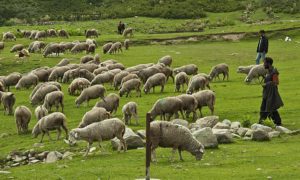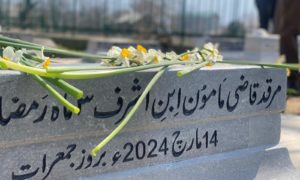A typical example of how corporate ventures on steroids, morph with state policy, and come at a human cost, Kishanganga power project has finally started operating in troubled waters at Gurez. After creating an ecological mess, human dislocations and land deprivations, the controversial powerhouse fed by Kashmir waters is only providing 13 percent of free power to the state.
On May 19, when Narendra Modi “dedicated” the state-run NHPC Ltd’s Kishanganga hydro power project in Jammu and Kashmir to “the nation”, a tribe of uprooted Gurezis turned up at Old City’s Naid Kadal, for a usual street chat amid the clampdown.
That day, Kashmir was welcoming the Indian premier with a shutdown. And fearing dissent, the authorities had put five Police Stations in Srinagar under routine “restrictions”.
Basking under the sun on a shopfront, the Gurezis—most of whom work as Wazwan chefs in the City—exchanged cold stares and signs, as the troopers nearby were enforcing the calm behind drop-gates and concertina wires.
After rendering them rootless, the power project and the news of its inauguration broke the men into a thoughtful chat.
“That power project has our curse,” said Anwar Khan, a 50-something browbeaten man among them. “It has come at the cost of our homes and lands.”
Inside a rickety house in Naid Kadal, where he put up as a tenant, Anwar sat a troubled man, struggling to voice the human tragedy that corporate projects are known to create of cultures and civilizations.
From the postcard meadows in Gurez where life was a total bliss for them, they’ve come to inhabit this defiant neighbourhood, being gassed and gagged, every now and then.

A view of Gurez.
Anwar calls Old City as his tribe’s second home, as most of his distant cousins live and work there.
Most of them moved to Old City after a controversial power project on Darya-e–Neelum aka Kishanganga, forced this Dard-Sheena tribe out of their historic homeland.
“We were different people having a different lifestyle,” said Anwar, as we sat to talk inside his room packed with his family members. “But now, see, what they’ve made of our lives.” His was one among the 400 odd families displaced by the 330-MW Kishanganga powerhouse from Gurez’s Badwan-Wanpora and Mastan Khopri.
ALSO READ: A peek into ‘democracy’ inside garrisoned Gurez
The displaced tribe is yet to be rehabilitated, Anwar said, even as the State High Court repeatedly set the deadlines to the government and NHPC, for the same. NHPC had promised a compensation of Rs 80 lakh to every displaced family in 2011, he said, which has come down to just Rs 24 lakh.
Through their counsel Altaf Mehraj, the tribe filed a petition in J&K High Court, demanding the compensation as per the National Rehabilitation and Resettlement Policy, 2007.
Before the project construction could begin in 2007, the Ministry of Rural Development department of Land Resources in its resolution had formulated the policy for providing rehabilitation and resettlement of the displaced persons.
ALSO READ: Where villagers are hostage to militarisation: Gurez, the barbed paradise
The government was to rehabilitate the uprooted Gurezis in Srinagar, following the land paucity in the garrisoned Gurez, nestled close to the Line of Control.

Children climb the nearby hill during Gurez festival organised by the department of tourism (FPK Photo/Utsa Sarmin)
Notably, 27 revenue villages of Gurez house 26,000 troops alongside 31,900 civilians, as per the latest census. Army occupies 2802 kanal, while 339 kanals are under LoC fencing in this picturesque valley. The Rs 3642.04 crore Kishanganga power project had devoured a total of 4280 kanals of land, leaving hardly any space for the rehabilitation.
At Mirgund, 16km from City Centre, a new colony with roads, hospitals and schools was promised to them, along with dislocation allowance and other benefits. Much of it never materialized and the tribe continues to live as tenants across Srinagar.
In Old City’s Nawa Kadal, Anwar’s distant relative Bashir Khan occupies another medieval house as a tenant. Making his living as a cab driver, Bashir turns animated over the mention of his lost roots.
“What’s the point of talking about the demise of our tribe,” he said, dismissively. “Even our MLA Nazir Gurezi would assure us that he’ll put the fight till he’s alive, to protect our homes and lands. But when those men came with huge machines under military cover, he behaved like a sitting duck.”
ALSO READ: Travelogue: A road trip to Gurez, and the longing of Habba Khatoon
While shuttling between Srinagar and Gurez, Nazir Gurezi says the power project has destroyed his constituency. Gurez, he says, used to be a different place before this project.
“But now,” MLA Gurez says, “the project has messed with our ecology and civilization.”
Nazir Gurezi’s Dard tribe is part of an ancient civilization — Dardistan. The tribe has found its mention in Greek historian Herodotus’s works.
The picturesque valley once housed the mighty Dard tribe, wielding influence from Afghanistan to Tibet. Their language Shin is spoken in Gilgit, Yasin, Satpara, Baltistan and other areas of the Himalayan belt. The tribe finds an honorable mention in Kalhana’s Rajtarangni, too.
As the gateway to the famous silk route across Asia, Gurez—having a distinction of giving Kashmir its only indigenous ruler, Yousuf Shah Chak—would connect Kashmir to Kashgar, a city in Xinjiang province of China. Historians argue that last Buddhist conference was held in Gurez, which even housed the Sharda Peeth University.
But after the “industrial-military complex” manifested into the power project in Gurez and ended up messing its historicity, Islamabad reacted fiercely.
As the controversial project envisages diverting water from the Kishanganga river through tunnels to the Wullar Lake in Bandipora, Pakistan has invoked the clauses of the Indus Water Treaty (IWT) to complain against India to the World Bank.
Islamabad is worried that the diversion of the river will dry its rice fields and impact Mangla Dam and other upcoming Neelam-Jhelum power project.
But so far, New Delhi has shrugged off most of these concerns.
“And now we’re told that we’ll only get 13 percent power from this project, for which we were given only two options — either leave on your own, or follow a government plan,” Anwar said.
“We followed the government plan, only to get uprooted. And now, thanks to this power project, our scattered tribe might become extinct over the next few decades.”
Like this story? Producing quality journalism costs. Make a Donation & help keep our work going.








